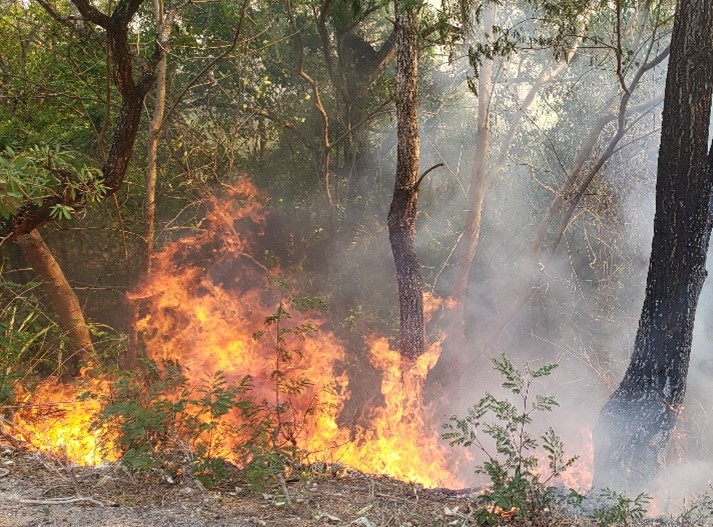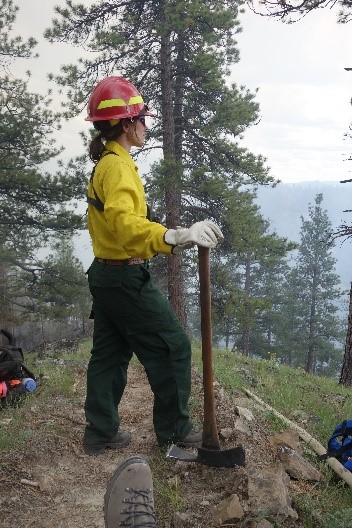Forests and Fire: Intersectionality of Forests and People

Throughout the Americas wildfires are changing. Forests are experiencing longer fire seasons, fires occurring outside of historic fire regions, fires burning more land on average each year, and more extreme fire behavior; some of which is attributed to a changing climate. Additionally, we are seeing an increased frequency of wildfires in populated area, impacting more homes and communities.
An IUFRO-sponsored panel discussion between scientists, practitioners and decision-makers examined forests and wildfire research in the Americas. Panelists noted that some of the wildfire management methods currently employed have been overtaken by events – primarily climate change – and new approaches and strategies that are more reflective of current conditions must be developed.
The Forests and Fire online discussion was one of three science-policy forums organized for IUFRO World Day. (The other two – Forests and Water and Forest-based Bioeconomy for All – are covered in separate Spotlights.) Forests and Fire was organized by the U.S. Forest Service and Embrapa, the Brazilian Agricultural Research Organization. Link to the forums: Science & Policy | IUFRO World Day
The complexity and challenges of living with wildfire have been compounded by climate change, the panelists said. Extreme drought, soaring temperatures, smoke, changing precipitation patterns and declining river levels in areas like the Pantanal in Brazil, are causing forest managers to reassess the ways in which they predict, prepare for, and manage wildfire.
In North America many wildland ecosystems have a history of fire – but with greatly varied patterns of fire frequency and type.
Now, as one of the panelists noted, effective firefighting is hampered as it becomes more and more common for several geographic areas to be managing large fires at one time. Fire management strategies, which traditionally could rely heavily on resource sharing, are finding themselves scrambling to find sufficient manpower as fires occur and move almost simultaneously between areas and across borders.
Several panelists emphasized that increased and continuing investment in advancing fire prediction models is needed to be effective going forward.

Those who are on the front lines fighting wildfires are finding that conditions on the ground can be quite different from what the modelling systems they rely on have predicted. The systems have been calibrated – over decades – to factor in such aspects as temperature and drought under normal weather conditions. But, as one of the forum panelists asked: “How do you predict into the extreme?”
Understanding the ecological role of fire is also essential for balancing the benefits and risks of alternative fire management strategies, the panelists said.
Prescribed and cultural fires are important and cost-effective ways to help manage forests. In addition to western science, traditional indigenous knowledge should also be included in fire management techniques. But a social licence for their use must be developed in the communities and people must be taught to use them wisely and at the appropriate time.
And, as populations increase and cities expand, more people are moving into outlying, more forested areas and are more vulnerable to the effects of wildfire. More work should be done, the panelists indicated, to assist those communities to learn how best to live safely with wildfire in those areas.
In certain regions, education campaigns could also help communities understand the best times of year to use fire to manage pastures and to share fire prevention messages, the panelists said.
Also suggested was the need to improve predictions of how human-induced land use will influence fire risk and to implement “red flags” when pyro-cumulonimbus cloud formations develop over existing fires. Those clouds can form their own weather systems, cause downwind lightning strikes and spawn new fires.
Participants did note that a significant amount of collaboration across countries and continents is already occurring. Countries are sharing firefighting services, collaborating on fire research, and working on various academic and community programs together to ensure knowledge and expertise are shared. And, it was noted that IUFRO plays an important role in this regard; convening experts and promoting global cooperation in forest-related research through its international network of scientists.
The opening remarks for the forum were given by Dr. Monica Lear of the USDA Forest Service and Dr. Erich Schaitza of Embrapa Florestas. The session was moderated by Randy Moore, Chief of the USDA Forest Service.
Panelists were:
Yucundo Coutino Estrada, Chiapas State, Natural Resources and State Parks, Mexico;
Aida R. Baldini Urrutia, Corporación Nacional Forestal (CONAF), Chile;
Balbina Maria Araujo Soriano, Embrapa Pantanal;
Dr. Sarah McCaffrey, USDA Forest Service;
Dr. Dan Thompson, Canadian Forest Service, Natural Resources Canada;
Dr. Frank Lake, USDA Forest Service;
Ross Smith, World Bank; and
Dr. Matt Jolly, USDA Forest Service.
Review the session at: https://www.youtube.com/watch?v=Mc7i67qNM84
IUFRO World Day was a worldwide digital event that took place Sept. 28-29 in three time zones around the world. It comprised 24 hours of forest-related research topics, networking, and emerging issues of relevancy for global policy makers. The event was designed to showcase the diversity of the IUFRO network, including IUFRO’s scientific units and IUFRO’s member organizations, to facilitate networking, and to enhance communication and outreach.
The World Day comprised 79 live sessions from IUFRO Units and Members – including the three forums mentioned above – covering highly relevant topics for policy makers as well as three central IUFRO sessions, one in each time zone. Over 3000 participants from more than 100 countries registered for the event. IUFRO: IUFRO World Day – Digital Forest Science Forum 2021 / Events
Note: Photos in this Spotlight issue have been kindly provided by the Science-Policy session organizers.
View all IUFRO Spotlights at http://www.iufro.org/media/iufro-spotlights/

Leave a Reply